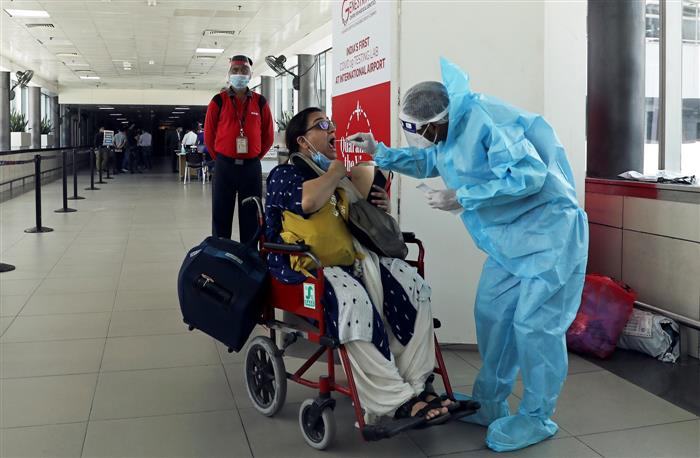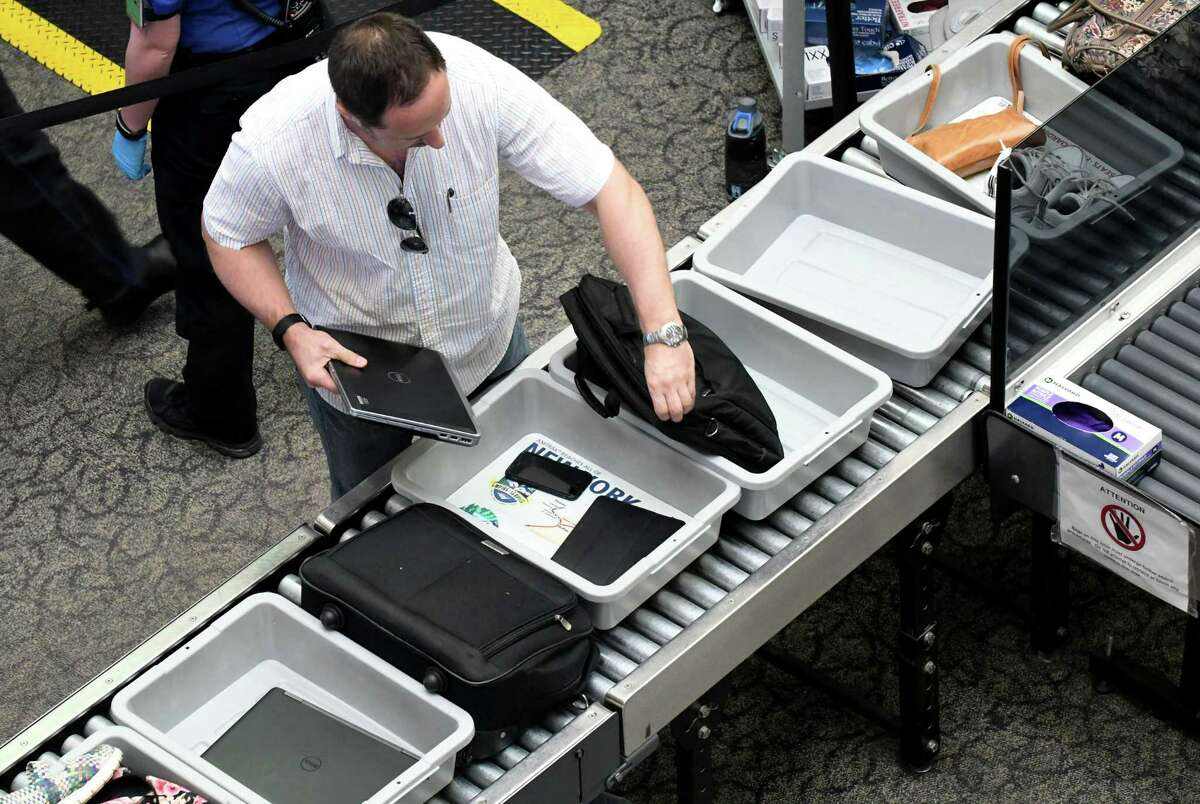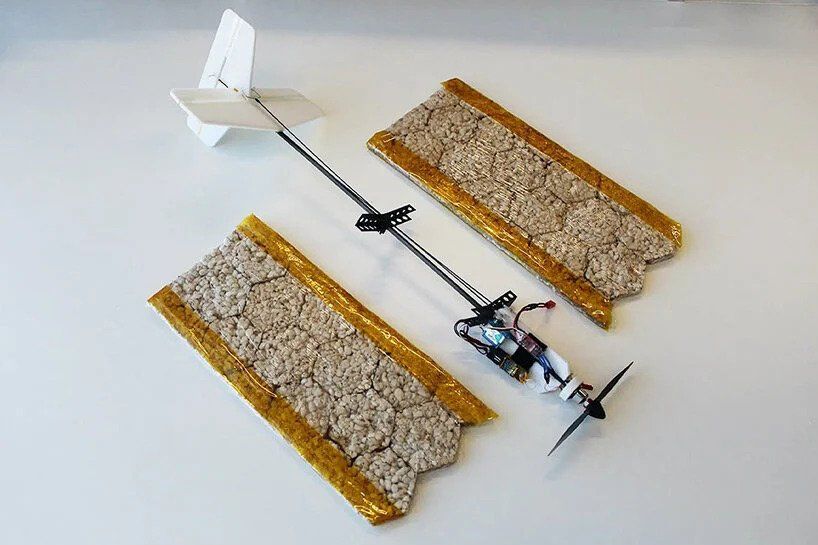2% of flyers will undergo random post-arrival testing at airports in India
Radhika Bansal
23 Dec 2022

In order to minimize the risk of ingress of BF.7, the new variant of coronavirus, in the country, the Ministry of Civil Aviation on Thursday decided that 2% of flyers will undergo random post-arrival testing at airports from December 24. Such passengers will be identified by the airline, preferably from different countries. They will be allowed to leave the airport after giving the sample. Samples testing positive will be sent for genome sequencing. The official notification reads, "A sub-section of 2% of the total passengers in the flight shall undergo random post-arrival testing at the airport on arrival." Ads by ADVERTISEMENT Ads by The notification said, "Such travellers will submit the samples and shall be allowed to leave the airport and a copy of the positive report shall be shared with Integrated Disease Surveillance Programme by the concerned Testing Laboratory (besides sharing with the APHOS) to be in turn shared with concerned State/UT for further follow up action." If any such travellers are tested positive, then their samples will be sent for genomic testing at the designated INSACOG laboratory network. This arrangement will come into the practice with effect from Saturday, 24th December, 2022. Ministry of Health and Family Welfare in its revised guidelines for international arrivals said that all travellers should preferably be fully vaccinated as per the approved primary schedule of vaccination. During the travel, if any passenger having symptoms of COVID-19 should be isolated as per standard protocol i.e. the said passenger should be wearing mask, isolated and segregated from other passengers in flight/travel and shifted to an isolation facility subsequently for follow up treatment. Physical distancing must be ensured while de-boarding. Thermal screening of all passengers should be done, the guidelines said. Travellers must self-monitor their health post arrival also report to their nearest health facility or call National helpline number (1075)/ State Helpline Number in case they have any symptoms suggestive, it said. Children under 12 years of age are exempted from post-arrival random testing. However, if found symptomatic for COVID-19 on arrival or during the period of self-monitoring period, they shall undergo testing and treated, it added. Meanwhile, Maharashtra Health Minister Tanaji Sawant said international travellers arriving in the state will undergo thermal testing amid concern of a possible spike in COVID-19 cases due to the BF.7 variant of Omicron. Key Points A sub-section of 2 per cent of total passengers in the flight undergo random post-arrival testing at the airport on arrival Travellers in each flight shall be identified by the airlines concerned and be preferably from different countries Such travellers will submit the samples and shall be allowed to leave the airport This arrangement will come into practice with effect from Saturday Physical distancing must be ensured while de-boarding Thermal screening of all passengers should be done
Read next
Drones that can increase their food payload from 30% to 50% of their mass were described in a publication earlier this month by researchers at the Swiss Federal Institute of Technology in Lausanne.
At the IEEE/RSJ International Conference on Intelligent Robots and Systems (IROS) conference in Kyoto, it was discussed how drones have proven effective in unmanned transport missions like the delivery of food and medical supplies to provide people in crises with life-saving nutrition and medication.
Commercial fixed-wing drones, on the other hand, can often only carry 10 to 30 per cent of their mass as payload. As a result, some drone components, such as the wings, might be built of food-grade materials, bringing the drone's mass ratio for transporting food to 50 per cent.
A flight-capable prototype can give 300 kcal and carry a cargo of 80 grams of water. Should the edible drone be left behind in the environment after performing its mission in an emergency circumstance, it will be more biodegradable than its non-edible version.
Due to the multirotor type drones' dependability when hovering and manoeuvring, some businesses have already started offering drone delivery services to save the cost of delivering small things on the last mile.
Drones can also be used to carry nutrients that will save lives for people in emergencies where ground vehicles have a tough time getting close. As a result, fixed-wing drones have an edge over multirotor drones.
Designboom
The edible wing has a wingspan of 678 mm because the volume of a fixed-wing drone's wing often takes up the most space. Conventional materials are used for the remaining structures, including the electronics, actuators, and fuselage.
To prevent bending or material failure during flight, the wing should be strong enough, which favours foam like expanded polypropylene (EPP) as the main structural material for traditional fixed-wing drones.
What's cooking?
One of the most promising candidates was a puffed rice cookie, which was formed by applying high pressure to rice grains at a high temperature and was easily machinable by laser cutting, according to rigorous scientific procedures, including Young's Modulus testing.
A kg of rice cookies has 3870 calories, which is less than other sweets that have over 5000 calories/kg of chocolate and candy, but their densities are five to eight times more than those of the rice cookie. Rice cookies are less dense and so more suited while still providing a very similar nutritional value to other common foods like oats, barley, and pasta.
To further offer a tiny quantity of nutrients to the edible wing, three types of edible adhesives were tested: gelatin, maize starch, and chocolate. Gelatin maintained a strong attachment until the material failure of the rice cookie itself. Gelatin was employed as an edible glue throughout the investigation since the team concluded that it was more durable than corn, starch, and chocolate.
Design and specs
Wing loading is a crucial design factor for aeronautical structures since it affects the lift coefficient, stall speed, and, in the case of an edible drone, the amount of food it can carry. The planar construction was adhered with gelatin in a hexagonal pattern to reduce the extra mass added by the edible adhesive, as seen below.
evtolinsights.com
One edible wing with a complete wingspan weighed 100 grams when the protective film was added. To prevent humidity damage, the entire wing surface was coated in plastic film and tape.
The electronics were placed at the front of the fuselage for balance during flight. The fuselage was composed of a 0.5 m long hollow carbon rod. Two tiny servo motors were employed as actuators for the tail wing's elevator and rudder, while a 300 kV brushless motor provided thrust.
A typical 2.4 GHz radio control transmitter and receiver set was used to remotely operate the motors. An 18.2 g Li-Po battery (7.4 V, 260 mAh) provided at least 10 minutes of flight time for the drone with edible wings. Without a payload, the total mass was 200 grams.
Despite being a prototype, the half-edible drone can fly, reaching speeds of roughly 10 meters per second after being equipped with a motor, several servos, and a small battery to control the tail surfaces.
Future research will concentrate on creating a novel method of storing payloads, such as water, on an edible drone without greatly expanding the surface area exposed to air. Since they are easy to make, it would be possible to use more than one edible drone to transport more food.
SOURCE: evtolinsights.com | spectrum.ieee.org
COVER: Designboom
Read next
Airbus plans to deepen its industrial presence in India, Chief Executive Guillaume Faury said on Wednesday, December 22 after meeting the country's prime minister.
"We will continue to support civil aviation growth and deepen our industrial footprint in India," Faury said on Twitter alongside a photograph of his meeting with India's Prime Minister Narendra Modi.
He did not provide further details. Faury's comments on industrial presence come as India is increasingly involved in the civil supply chain.
https://twitter.com/GuillaumeFaury/status/1605478296409362433
A senior Boeing Co official told ET Infra in September that India had shown resilience during the pandemic and that Boeing and other companies would make increased use of its suppliers.
The meeting between the world's largest civil planemaker and the leader of the world's fastest-growing airline market also coincides with a potentially huge Air India jet purchase, though industry sources said this was not the main focus of the visit.
Airbus plans to deepen its industrial presence in India, Chief Executive Guillaume Faury said
Air India is in the advanced stages of negotiating a major fleet renewal and expansion under new owner Tata Group that industry sources say could involve 250 Airbus jets including 200-210 A320neo-family jets and over three dozen A350s.
Airbus also hopes to secure a new home at Air India for six A350s originally earmarked for Russia's Aeroflot, though it remains unclear whether these are included in the main order.
ALSO READ - Air India jumbo aircraft order to include B737 MAX and B787 Dreamliner
Air India is also close to a deal to buy some 190 Boeing 737 MAX jets and 30 of its B787 Dreamliners as part of the same package potentially close to 500 aircraft, Reuters reported last week. The deal could also involve a handful of larger 777X jets.
After intense talks in the past week, outlines of a package worth tens of billions of dollars are taking shape but the timing of any announcement remains unclear, the sources said. Big-ticket aircraft negotiations typically go down to the wire and can break down at the last minute over contractual details like deposits and inflation clauses.
Airbus declined to comment and Tata Group was not immediately available to comment.
In October, Tata Group and Airbus said they would make the C-295 military transport aircraft in India.
India, among the world's largest defence importers, has been trying to cut its reliance on foreign firms and increase local output. Only state-owned Hindustan Aeronautics Ltd currently makes aircraft, mainly for the armed forces.
(With Inputs from Reuters)
Read next
The Airports Authority of India (AAI) on Wednesday, December 21 said the overall project work of Ayodhya airport is expected to be completed by June 2023. The airport development project is worth INR 242 crore. It includes the construction of a terminal building and the development of airside facilities.
"The new terminal building with a total area of 6,000 sq.m.is being designed to serve 300 passengers during peak hours with an annual handling capacity of 6 lakh passengers," AAI said in a release.
Ayodhya airport to be completed by June 2023
52% of development work has been completed till now and overall project work is expected to be completed by June 2023. This airport will not only put the pilgrimage site on the aviation map but also give a boost to the economic development of the region. Direct air routes to this important religious destination would facilitate seamless and direct connectivity for pilgrims all over the world.
ALSO READ - AAI has begun the construction of Ayodhya airport
The design of the airport will reflect the idea and spirit of Ram Mandir, invoking a sense of spirituality and creating a sense of place for all passengers arriving and departing from the airport... The glass façade of the terminal will be designed to recreate a sense of being in the very palace of Ayodhya.
The roof of the terminal is proposed to be adorned with shikharas, of varying heights to convey a sense of grandeur to the structure. The terminal will have decorative columns displaying important events from Ramayana pictorially. The building will shine aesthetically and functionally, displaying a perfect mix of local architecture with a modern architectural note," AAI said in a statement detailing the upcoming airport's architectural aspects.
Direct air routes to this important religious destination would facilitate seamless and direct connectivity for pilgrims all over the world.
ALSO READ - UP government signs lease agreement with AAI to transfer land for Ayodhya Airport
The Ayodhya airport is among several projects of the Centre and the state government that have been approved for the temple town. Ayodhya Airport is the fifth international airport in Uttar Pradesh (after Lucknow, Varanasi, Kushinagar and Noida).
In 2008, the Ayodhya Airport was handed over by the government of Uttar Pradesh to the Airports Authority of India (AAI) to be developed as a full-fledged airport along with three others (Meerut, Moradabad and Saifai) with the approval of the Uttar Pradesh cabinet. The government of Uttar Pradesh is providing extra land free of cost for further expansion and for the construction of a terminal.
Read next
BCAS to issue norms where electronic devices will be scanned inside the bag only
Radhika Bansal
22 Dec 2022

The long queues of air travellers removing their laptops, mobile phones and chargers from their cabin baggage before screening them could soon become history in India. The aviation security regulator, the Bureau of Civil Aviation Security (BCAS), is expected to issue technical norms within a month which will pave the way for airports to adopt modern equipment to screen bags without removing electronic devices.
“Newer technologies are needed for better security as well as passenger convenience,” BCAS director general Zulfiquar Hasan told The Hindu.
“All airports, including Delhi airport, need to improve the machines deployed for screening of cabin bags. They are lagging behind. Technologies such as dual x-ray, computer tomography and neutron beam technology will eliminate the need for passengers to remove laptops and other electronic devices,” a senior official of the Central Industrial Security Force (CISF), which oversees airport security, told The Hindu on the condition of anonymity.
Over-crowded airports
The call for modernisation comes at a time when airports across the country are seeing a record number of air travellers that have already exceeded pre-Covid levels. A total of 4.27 lakh domestic travellers were seen on December 11. At Delhi airport, which recently witnessed scenes of over-crowding resulting in passengers missing their flights, security lanes were found to be the biggest congestion points primarily because the number of x-ray machines for screening cabin bags were not commensurate with passenger traffic during peak hours.
Senior government officials have blamed airports for failing to grow their infrastructure to cater to growing number of flights and passengers, and Civil Aviation Minister Jyotiraditya Scindia stepped in to order the airport operator to provide more machines for screening cabin bags. While CISF provides its personnel, security infrastructure at airports is the airport operator’s prerogative.
While the traditional x-ray machines currently used at airports produce a 2-D image, newer technologies such as computer tomography produce a 3-D image with a higher resolution, and have better automated detection of explosives. They also have a low rate of the false alarms which often lead to CISF personnel requiring a physical inspection of a bag. These factors result in a higher baggage throughput (or flow) through the machine.
Faster passenger flow
“Better technology will result in a faster throughput, and will allow airports to accommodate more flights per hour and will ultimately allow for growth in the aviation sector. This will also make up for the investment made in acquiring new equipment,” the senior CISF official said.
He also said that it was not acceptable to blame security personnel for congestion as they were under immense pressure because their job is a “zero error business”.
The technical specifications for modern machines for screening cabin bags are likely to be issued within a month, according to a senior official of the Ministry of Civil Aviation. These will accompany a new set of technical specifications and trial directives for the much-delayed full-body scanners to be installed at airports for detecting non-metallic items on passengers once they pass through the existing door-frame metal detectors.
The initial BCAS deadline for installing them was March 2020, but it has been extended multiple times, and now stands pushed to December 2023.
Chinese scanners dropped
The Airports Authority of India had to withdraw a 2019 tender for the full-body scanners which had been awarded to Chinese company Nuctech, following a government advisory in 2020 barring purchases from bordering countries after the standoff at Doklam. The cancellation of the tender also meant that airports would now have to spend double the money in acquiring body scanners from American companies such as Smiths and L-3 or Germany’s Rohde & Schwarz.
Since the uproar on over-crowding in the past two weeks, Delhi airport has provided space and equipment for additional security lanes at both domestic and international sections of Terminal 3 as well as Terminal 2, which is for domestic flights only.
The CISF has also deployed 262 personnel over and above the 4,800 already deployed at Delhi airport alone. Leaves and weekly offs for most personnel have also been cancelled till the end of January. Only 1.8% of the total personnel deployed are allowed to avail a weekly off.
(With Inputs from The Hindu)
Read next
To promote the uniform, secure, and effective implementation of U-space throughout the European Union, the European Union Aviation Safety Agency has released its first set of Acceptable Means of Compliance and Guidance Material.
The management of unmanned aircraft traffic to ensure the safety of interactions with other entities using the same space in urban areas and other locations has come to be known as "U-space."
Representative | EASA
This is a significant step for the drone service market, as U-space airspace and services implementation enables more complex drone operations beyond the visual line of sight, such as drone operations in an urban environment, across European airspace. This major EASA deliverable would not have been possible without the active involvement of the European drone and aviation community. The implementation of U-space airspace and U-space services represents the first step towards the safe integration of manned and unmanned traffic in the airspace- said Patrick Ky, Executive Director of EASA
More than 30 specialists, as well as officials from the civil aviation authorities and industry, worked together under the direction of EASA to produce the paper that was eventually released. The AMC/GM for the U-space regulatory framework represents the state-of-the-art of U-space concept, systems, and technology and has been designed taking into account the most recent innovations from industry and U-space stakeholders. As a result of the AMC/thorough GM's treatment of the U-space regulation's many facets and key players, U-space will be implemented across Europe in a way that is equitable, effective, secure, and safe.
Representative | EASA
As of January 26, 2023, when the U-space regulatory framework (Regulations (EU) 2021/664, (EU) 2021/665, and (EU) 2021/666) officially enters into force, EASA looks forward to the next phases of the U-space implementation.
Representative | EASA
The first U-space airspace designations and U-space service provider (USSP) certifications will be made shortly as part of the implementation process. Beyond creating the legal framework, EASA will continue to actively contribute to the deployment of U-space by accrediting USSPs from third countries (non-EU) that want to provide services in Europe.
consilium.europa.eu
The Agency will eventually be able to improve the initial set of AMC/GM based on the lessons learned during the first few years of drone operations in the U-space thanks to the experience all U-space stakeholders obtained during the early deployments.
SOURCE: easa.europa.eu
COVER: Eurocontrol






Comment